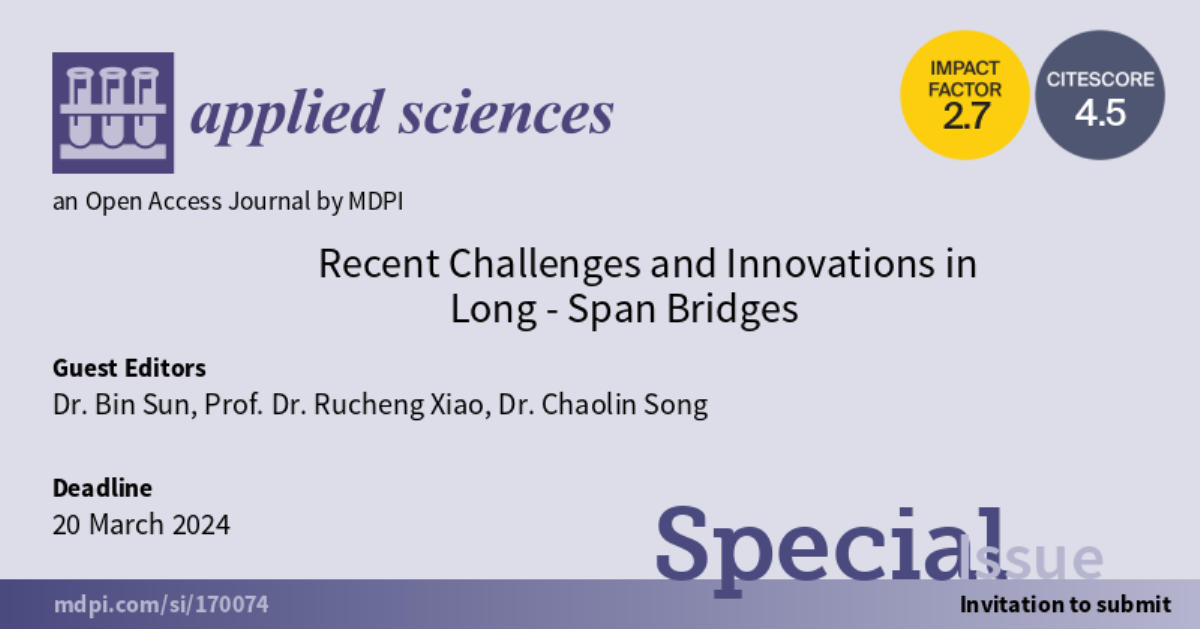Recent Challenges and Innovations in Long-Span Bridges
A special issue of Applied Sciences (ISSN 2076-3417). This special issue belongs to the section "Civil Engineering".
Deadline for manuscript submissions: closed (20 March 2024) | Viewed by 3542

Special Issue Editors
Interests: long-span bridges; application of UHPC in bridge engineering
Interests: bridge engineering; bridge structural systems; bridge design theory and optimization; bridge management systems
Special Issue Information
Dear Colleagues,
In recent decades, many long-span bridges have been constructed to cross rivers, canyons, and other natural or manmade obstacles, forming an important part of modern transportation networks. Bridge engineers are confronted with many challenges in the design, construction, and maintenance of long-span bridges. Technological developments and innovations provide a fundamental approach to tackle these challenges. This Special Issue aims to collect papers regarding recent developments and innovations in long-span bridges. Potential topics include, but are not limited to, the design and construction practices of long-span bridges; applications of new materials in bridge engineering; innovative bridge structures and systems; machine-learning-enhanced bridge design and monitoring; and the risk, reliability and resilience analysis of long-span bridges.
Dr. Bin Sun
Prof. Dr. Rucheng Xiao
Dr. Chaolin Song
Guest Editors
Manuscript Submission Information
Manuscripts should be submitted online at www.mdpi.com by registering and logging in to this website. Once you are registered, click here to go to the submission form. Manuscripts can be submitted until the deadline. All submissions that pass pre-check are peer-reviewed. Accepted papers will be published continuously in the journal (as soon as accepted) and will be listed together on the special issue website. Research articles, review articles as well as short communications are invited. For planned papers, a title and short abstract (about 100 words) can be sent to the Editorial Office for announcement on this website.
Submitted manuscripts should not have been published previously, nor be under consideration for publication elsewhere (except conference proceedings papers). All manuscripts are thoroughly refereed through a single-blind peer-review process. A guide for authors and other relevant information for submission of manuscripts is available on the Instructions for Authors page. Applied Sciences is an international peer-reviewed open access semimonthly journal published by MDPI.
Please visit the Instructions for Authors page before submitting a manuscript. The Article Processing Charge (APC) for publication in this open access journal is 2400 CHF (Swiss Francs). Submitted papers should be well formatted and use good English. Authors may use MDPI's English editing service prior to publication or during author revisions.
Keywords
- long-span bridges
- bridge design and optimization
- bridge construction
- bridge maintenance
- structural health monitoring
- reliability and resilience
Benefits of Publishing in a Special Issue
- Ease of navigation: Grouping papers by topic helps scholars navigate broad scope journals more efficiently.
- Greater discoverability: Special Issues support the reach and impact of scientific research. Articles in Special Issues are more discoverable and cited more frequently.
- Expansion of research network: Special Issues facilitate connections among authors, fostering scientific collaborations.
- External promotion: Articles in Special Issues are often promoted through the journal's social media, increasing their visibility.
- e-Book format: Special Issues with more than 10 articles can be published as dedicated e-books, ensuring wide and rapid dissemination.
Further information on MDPI's Special Issue polices can be found here.





